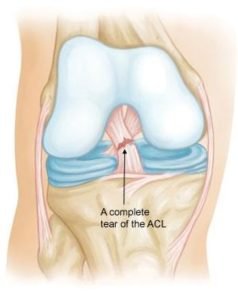Dr Amit Saoji | Orthopedic Surgeon In Nagpur | Orthopedic Doctor in Nagpur
ACL In Nagpur
Home / ACL In Nagpur

ACL
An ACL injury could be a tear or sprain of the anterior symmetric (KROO-she-ate) ligament (ACL) — one amongst the sturdy bands of tissue that facilitate connect your thigh bone (femur) to your shin (tibia). ACL injuries most ordinarily occur throughout sports that involve unexpected stops or changes in direction, jumping and landing — like football, basketball, soccer and downhill sport.
Many people hear a pop or feel a “popping” sensation within the knee once Associate in Nursing ACL injury happens. Your knee might swell, feel unstable and become too painful involved weight.
Depending on the severity of your ACL injury, treatment might embrace rest and rehabilitation exercises to assist you regain strength and stability, or surgery to interchange the torn ligament followed by rehabilitation. a correct educational program might facilitate scale back the danger of Associate in Nursing ACL injury.
Symptoms
Signs Associate in Nursingd symptoms of an ACL injury typically include:
A loud pop or a “popping” sensation within the knee
Severe pain and inability to continue activity
Rapid swelling
Loss of vary of motion
A feeling of instability or “giving way” with weight bearing
When to call a doctor
Seek immediate care if Associate in Nursingy injury to your knee causes signs or symptoms of an ACL injury. The articulatio genus could be a complicated structure of bones, ligaments, tendons and different tissues that job along. It’s vital to urge a prompt and correct identification to work out the severity of the injury and obtain correct treatment.
Causes
Ligaments area unit sturdy bands of tissue that connect one bone to a different. The ACL, one amongst 2 ligaments that cross within the middle of the knee, connects your femur to your shin and helps stabilize your articulatio genus.
ACL injuries usually happen throughout sports and fitness activities that may place stress on the knee:
Suddenly swiftness down and dynamical direction (cutting)
Pivoting together with your foot firmly planted
Landing awkwardly from a jump
Stopping suddenly
Receiving an instantaneous blow to the knee or having a collision, like a soccer tackle
When the ligament is broken, there’s typically a partial or complete tear of the tissue. a gentle injury might stretch the ligament however leave it intact.
Risk factors
There area unit variety of things that increase your risk of Associate in Nursing ACL injury, including:
Being feminine — presumably because of variations in anatomy, muscle strength and secretion influences
Participating in bound sports, like football, football, basketball, athletics and downhill sport
Poor learning
Using faulty movement patterns, like moving the knees inward throughout a squat
Wearing footwear that doesn’t work properly
Using poorly maintained sporting goods, like ski bindings that aren’t adjusted properly
Playing on artificial turf
Complications
People who expertise Associate in Nursing ACL injury have the next risk of developing degenerative joint disease within the knee. inflammatory disease might occur notwithstanding you’ve got surgery to reconstruct the ligament.
Multiple factors doubtless influence the danger of inflammatory disease, like the severity of the first injury, the presence of connected injuries within the articulatio genus or the extent of activity once treatment.
Prevention
Proper coaching and exercise will facilitate scale back the danger of ACL injury. A medical specialty Dr., physiotherapist, athletic trainer or different specialist in medical specialty will give assessment, instruction and feedback that may assist you scale back risks.
Programs to scale back ACL injury include:
Exercises to strengthen the core — as well as the hips, pelvis and lower abdomen — with a goal of coaching athletes to avoid moving the knee inward throughout a squat
Exercises that strengthen leg muscles, significantly hamstring exercises, to confirm Associate in Nursing overall balance in leg muscle strength
Training and exercise accenting correct technique and knee position once jumping and landing from jumps
Training to enhance technique once playacting pivoting and cutting movements
Training to strengthen muscles of the legs, hips and core — additionally as coaching to enhance jumping and landing techniques and to stop inward movement of the knee — might facilitate to scale back the upper ACL injury risk in feminine athletes.
Activity
Wear footwear and artifact that’s acceptable for your sport to assist forestall injury. If you downhill ski, check that your ski bindings area unit adjusted properly by a trained skilled so your skis can unharness befittingly if you fall.
Wearing a brace doesn’t seem to stop ACL injury or scale back the danger of revenant injury once surgery.
